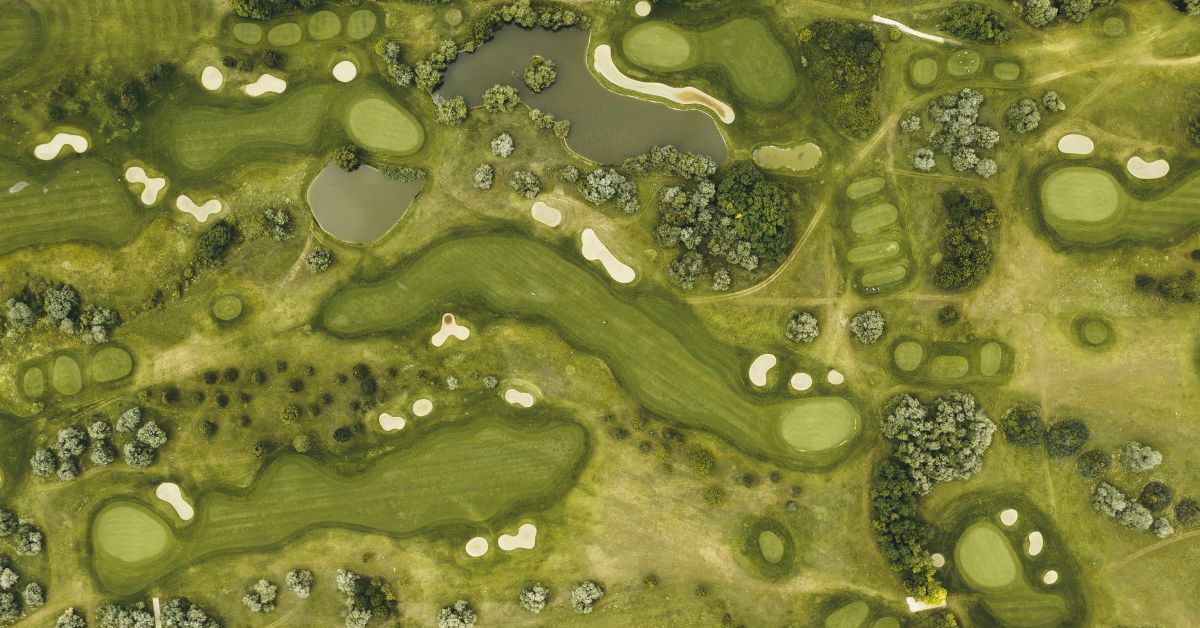In recent years, par 72 has become a standard in golf course design.
From memory, almost every golf course I’ve played has been par 72. This often comprises ten par 4 holes, four par 3s, and four par 5s.
However, not all golf courses are par 72.
In this guide, I’ll explain what determines the par score for an 18-hole golf course.
Are All Golf Courses Par 72?
Not all golf courses are par 72. Par for an 18-hole course is assigned based on factors like distance and difficulty, usually falling between 68 and 73. Recently, the USGA has made an effort to set 72 as the baseline score, so many new courses are built to this standard.

What Exactly Is Par in Golf?
In golf terms, par is the predetermined number of strokes that a scratch golfer should require to complete the hole, a round, or a tournament.
Historically, the word par is derived from a stock exchange term that a stock may be above or below its normal, or par figure.
The word first appeared in golf during The Open Championship in 1870, when golf writer A.H. Doleman used the term to describe “perfect play” for the round. At the time, the par score was equivalent to 49 through twelve holes.
Since then, the term has grown to be hugely significant in the sport.
Which Course Factors Determine Par?
Essentially, two predominant factors affect the par score for any given hole on the golf course: length and difficulty.
Length
The first, and by far the most significant factor influencing the par of a golf course is the overall length of the course.
According to the USGA, it is recommended that par be established for each hole according to the following hole lengths:
| Par | Men | Women |
|---|---|---|
| 3 | Up to 260 yards (240 meters) | Up to 220 yards (200 meters) |
| 4 | 240 to 490 yards (220 to 450 meters) | 200 to 420 yards (180 to 380 meters) |
| 5 | 450 to 710 yards (410 to 650 meters) | 370 to 600 yards (340 to 550 meters) |
| 6 | 670 yards and up (610 meters and up) | 570 yards and up (520 meters and up) |
Shorter golf courses have a lower par score.
Take Royal St. David’s as an example. This par 69 course measures a total distance of just 6,500 yards from the back tees and is noted for its succession of long testing par 4 holes and five par 3s.

Longer courses push the par score higher.
Less than 100 out of over 16,000 courses in the US are par 73s, according to the National Golf Foundation, well under 1 percent of the nation’s supply.
One such example is Streamsong Black, a relatively new golf course in Florida that measures a whopping 7,400 from the back tees.

Difficulty
The second factor to consider when determining par is the difficulty.
Where a hole length falls within two par ranges as indicated in the table above, par is chosen according to the perceived difficulty of the hole.
Altitude, terrain, wind direction, and on-course obstacles such as water hazards, trees, bunkers, mounds, and even buildings can be taken into consideration when creating the golf course par.
This ensures the par figure is set as fairly as possible, without relying on distance.
Another factor to consider is the size of the greens. Larger greens make approach shots easier, decreasing the hole’s difficulty.
The 4/10/4 Layout
Put simply, the most common arrangement of holes is four par 3’s, ten par 4’s, and four par 5’s, forming the frequently seen par 72 golf course.
This 4/10/4 layout has become a standard in modern golf course design, testing the golfer’s skill with a symmetrical balance of holes.
As a result, almost all golf courses built today are par 72.

Why Are Par 73 Courses So Rare?
To reach par 73, golf course designers must break away from the typical 4/10/4 course arrangement. This usually requires choosing one of two options:
- Creating a par 5 in place of a par 4
- Dropping to only three par 3s
The main difficulty with option 1 is that to accommodate this, the golf course must have enough land. This can be challenging for many course owners, where courses already occupy large amounts of land at significant maintenance costs.
Furthermore, longer golf courses take longer to build. And with longer build timelines, courses inevitably become more expensive to build.
Par 5 holes are also the hardest to design, according to golf course designer Tom Doak. So, including more in a design appears to be an unnecessary challenge.
“Generally, par-5 holes are the hardest to design — there aren’t many great ones — so trying to include more of them in a design makes it harder to build a great course.”
Tom Doak via GolfPass
Alternatively, dropping to three par 3s can be seen as controversial by many golfers and is not always an ideal solution. This is simply because par 3s are an important element of the golf course, and only three par 3s in total can feel underwhelming.
Ultimately, par 73 golf courses are rare as they require building an extra par 5 hole, or dropping to just three par 3 holes. For some golf course architects, this can make the design feel less balanced.

FAQs
Can a Hole Have Multiple Pars?
In some cases, it is possible for a hole to have more than one par score due to the positioning of the tee boxes.
For example, the forward tees can play as a par 5 while the backs play as a par 4. This would be indicated on the scorecard as par 4/5 for the hole.
Who Decides What Par Should Be?
Typically, the course architect will determine the par for each hole or at least recommend par outlines to the course owner.
The course owner may ultimately make amendments to the par over time, as course difficulty is determined by numerous playing factors including wind direction and slope.

Conclusion
In summary, not all golf courses are par 72.
Ultimately, the designated par for a golf course can vary based on two factors:
- Distance — the total distance of a golf course
- Difficulty — the significance of altitude, terrain, and obstacles
As a result, the par for a course can be set anywhere from 68 to 73. However, par 72 courses are the most common, often featuring a 4/10/4 hole arrangement.


